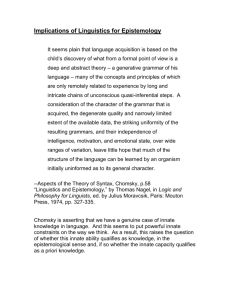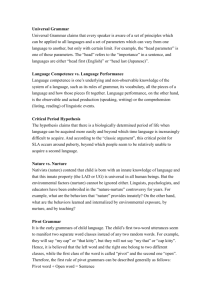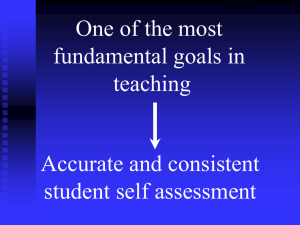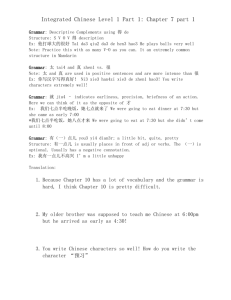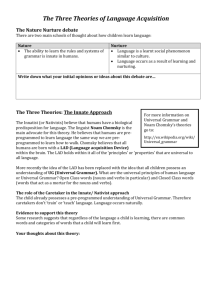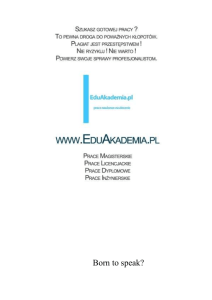LAZ B1 Listening Exam 1 05 2014
advertisement
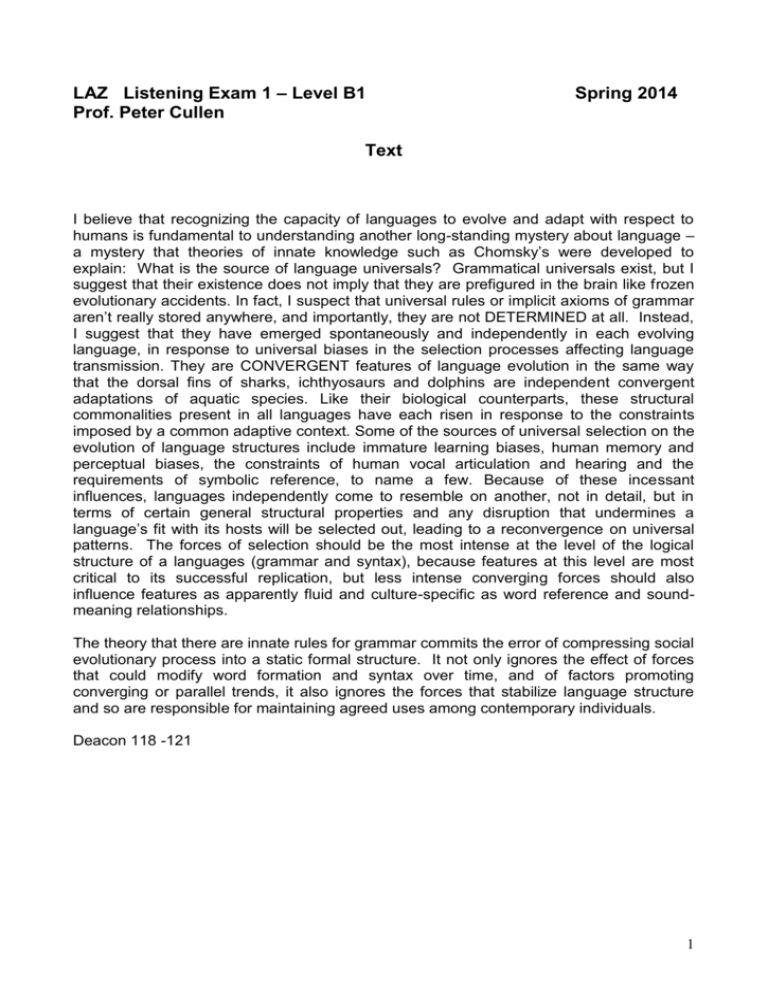
LAZ Listening Exam 1 – Level B1 Prof. Peter Cullen Spring 2014 Text I believe that recognizing the capacity of languages to evolve and adapt with respect to humans is fundamental to understanding another long-standing mystery about language – a mystery that theories of innate knowledge such as Chomsky’s were developed to explain: What is the source of language universals? Grammatical universals exist, but I suggest that their existence does not imply that they are prefigured in the brain like frozen evolutionary accidents. In fact, I suspect that universal rules or implicit axioms of grammar aren’t really stored anywhere, and importantly, they are not DETERMINED at all. Instead, I suggest that they have emerged spontaneously and independently in each evolving language, in response to universal biases in the selection processes affecting language transmission. They are CONVERGENT features of language evolution in the same way that the dorsal fins of sharks, ichthyosaurs and dolphins are independent convergent adaptations of aquatic species. Like their biological counterparts, these structural commonalities present in all languages have each risen in response to the constraints imposed by a common adaptive context. Some of the sources of universal selection on the evolution of language structures include immature learning biases, human memory and perceptual biases, the constraints of human vocal articulation and hearing and the requirements of symbolic reference, to name a few. Because of these incessant influences, languages independently come to resemble on another, not in detail, but in terms of certain general structural properties and any disruption that undermines a language’s fit with its hosts will be selected out, leading to a reconvergence on universal patterns. The forces of selection should be the most intense at the level of the logical structure of a languages (grammar and syntax), because features at this level are most critical to its successful replication, but less intense converging forces should also influence features as apparently fluid and culture-specific as word reference and soundmeaning relationships. The theory that there are innate rules for grammar commits the error of compressing social evolutionary process into a static formal structure. It not only ignores the effect of forces that could modify word formation and syntax over time, and of factors promoting converging or parallel trends, it also ignores the forces that stabilize language structure and so are responsible for maintaining agreed uses among contemporary individuals. Deacon 118 -121 1 LAZ Listening Exam 1 – Level B1 Spring 2014 ______/30 Prof. Peter Cullen ___________________________________________ Name, Date, and Registration Number Questions: You do not have to use complete sentences! This is a listening exam. SIMPLE AND CORRECT IS BETTER THAN COMPLICATED AND WRONG. 1. What does the author believe is fundamental to understanding the emergence of language universals? 2. How does the author suggest language universals emerged? 3. How have did the structural commonalities of languages each risen? 4. Why should the forces of selection be the most intense at the level of the logical structure of a languages (grammar and syntax)? 5. What is the error of the theory of innate grammatical rules? ______/20 True or False: Write “True” or “False” in the space next to each statement 1. Chomsky developed a theory of innate knowledge. ________________ 2. Rules and axioms of language are stored in memory. ________________ 3. Disruptions in a language usage’s fit with social needs will be selected out. ________________ 4. Sound-to-meaning relationships are not as intense as grammar and syntax. ________________ 5. Chomsky’s innate grammar theory ignores the forces that give languages stability. ________________ ______/10 2 LAZ Listening Exam 1 – Level B1 Prof. Peter Cullen Spring 2014 Answer Sheet 1. What does the author believe is fundamental to understanding the emergence of language universals? that recognizing the capacity of languages to evolve and adapt with respect to humans 2. How does the author suggest language universals emerged? have emerged spontaneously and independently in each evolving language, in response to universal biases in the selection processes affecting language transmission 3. How did the structural commonalities of languages develop? in response to the constraints imposed by a common adaptive context. 4. Why should the forces of selection be the most intense at the level of the logical structure of a languages (grammar and syntax)? because features at this level are most critical to its successful replication. 5. What is the error of the theory of innate grammatical rules? commits the error of compressing social evolutionary process into a static formal structure True or False: Write “True” or “False” in the space next to each statement 1 2 3 4 5 T F T T T 3
